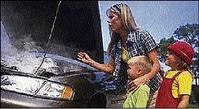Paul Messam, Gleaner writer
Maintenance of the cooling systems in your vehicle is very important.
There is nothing as frustrating to a motorist as a boiling car engine. If the red temperature light flickers on and off, it is advised that the motorist turn on the heater, which will draw heat away from the engine. However, "continue driving only if the light stays off," warns Andrew Brown, an experienced St Andrew based auto-Mechanic.
There can be no debate on the point that the cooling system is one of the hardest working systems of the entire motor vehicle. "Even the automatic transmission, frequently relies on the engine's cooling system to maintain proper operating temperature," says Brown.
Some motorists neglect the cooling system of their vehicles and they do this at their own peril. According to Brown, an efficient leakproof cooling system should operate for months under normal driving conditions without you having to add fluid. However, proper maintenance is necessary.
big engine problems
The failure of any one of the many cooling-system components can create big engine problems. Brown explains that a boiling engine or overheating, could crack the engine block. This could mean a new engine, and excessive heat can also destroy the cylinder heads. If the cooling system operates at too low a temperature (may be due to thermostat problems), oil circulation may be restricted or completely blocked by the formation of sludge and the engine will fail.
If the light stays on, or if the needle moves up to the "H" marker, quickly pull over safely to the side of the road and turn off the engine. Examine for a leak in the heater or radiator hoses. If the leak is under a clamp, tighten the clamp with a screwdriver. If one sees a small leak in the hose, allow enough time for the engine to cool. For safety's sake, put on goggles and cautiously remove the cap. Then tape the hose leak with the strong duct tape. Now, with the engine running, add water to the radiator. Afterwards replace the cap but leave it one notch looser, a tight cap will pressurize the system and blow open your patch. Then drive immediately to the nearest gas station or garage.
steam pressure
The mechanic says that if you are driving and notice volumes of steam pouring from your engine, open the hood or bonnet to hasten the cooling process. Wait a while until you are certain the steam pressure has dropped before opening the radiator pressure cap; otherwise you could be severely burnt. "After the engine has cooled, start the vehicle and pour water in," he advises.
Some Auto experts suggest that hot water is ideal to pour in the radiator. Brown agrees and cautions that one should never add cold water immediately after the engine has been boiling. "When you have added water, drive to the nearest service station or to mechanic shop, to have the cooling system pressure tested for leaks and repaired as necessary. Under absolutely no circumstance should the motor car be driven until the radiator has been filled," says Brown.
external leaks
The mechanic explains that even after the water has boiled over, the radiator will need frequent topping up. Even if there are no external leaks, it could mean that the head or block is cracked internally or that the head gasket is blown. Therefore, continued driving will allow coolant to run down into the pan and contaminate the oil and ruin the engine. Also, whenever the coolant (that green liquid, sometimes pink in colour) begins to disappear from the radiator, even if there has not been a boiling trouble, check it as it must be travelling somewhere. If this happens, consult your mechanic without delay. Delay is danger.

